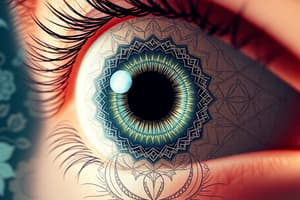Podcast
Questions and Answers
What is the primary focus of increasing complexity in optometry with regards to treatment options?
What is the primary focus of increasing complexity in optometry with regards to treatment options?
- Increasing the number of ocular imaging techniques
- Enhancing data interpretation and decision making (correct)
- Reducing the number of treatment options available
- Simplifying refractive error management
Which instrument is used primarily for measuring the cornea's curvature?
Which instrument is used primarily for measuring the cornea's curvature?
- Pachymeter
- Topographer
- Ophthalmometer
- Keratometer (correct)
What is a key factor in ensuring proper refraction through the cornea?
What is a key factor in ensuring proper refraction through the cornea?
- Rigidity of the corneal structure
- Increased thickness of the cornea
- Increased variability in corneal shape
- Uniform smoothness of the corneal surface (correct)
Which of the following best describes keratometry?
Which of the following best describes keratometry?
What does corneal topography primarily assess?
What does corneal topography primarily assess?
What can result from a loss of smoothness on the corneal surface?
What can result from a loss of smoothness on the corneal surface?
Which option is NOT a purpose of using a keratometer?
Which option is NOT a purpose of using a keratometer?
Which aspect of corneal characteristics can be determined using advanced instrumentation?
Which aspect of corneal characteristics can be determined using advanced instrumentation?
What is the primary reason for choosing to change corneal shape rather than other ocular structures to modify refractive power?
What is the primary reason for choosing to change corneal shape rather than other ocular structures to modify refractive power?
What optical component is primarily involved in the process of emmetropisation?
What optical component is primarily involved in the process of emmetropisation?
Which description best characterizes spherical aberration (SA)?
Which description best characterizes spherical aberration (SA)?
What does a Q value of zero indicate about a cornea's shape?
What does a Q value of zero indicate about a cornea's shape?
What happens to the total ocular spherical aberration with aging?
What happens to the total ocular spherical aberration with aging?
In comparison to spectacle lenses, how does the radius of curvature of the cornea differ?
In comparison to spectacle lenses, how does the radius of curvature of the cornea differ?
Which parameter does NOT contribute to corneal asphericity?
Which parameter does NOT contribute to corneal asphericity?
Which of the following dynamics occurs in relation to the pupil size and the spherical aberration effect?
Which of the following dynamics occurs in relation to the pupil size and the spherical aberration effect?
What is the shape of the typical human cornea?
What is the shape of the typical human cornea?
Flashcards are hidden until you start studying
Study Notes
Optometry and Instrumentation
- Optometry is getting more complex due to the growing complexity of spectacle, contact lenses, and surgical options available.
- The complexity of treatment options means that detailed quantification of eye parameters is required.
- Advancements in instrumentation ensure easy to use imaging techniques are available.
- Optometrists are increasingly required to interpret and use data for decision-making.
Corneal Topography
- Corneal topography is the measurement of the cornea's shape and height
- There are different types of instruments used to measure corneal topography
- Early keratometers, like Javal Schiotz, were developed in 1881
- The cornea needs to be a smooth surface for refraction
- The cornea contributes significantly to the eye’s refractive power
- Changing corneal shape can alter the total refractive power of the eye
Corneal Curvature
- The cornea provides roughly 2/3rds of the refractive power of the eye
- The cornea has a steeper curve than a spectacle lens
- Emmetropization is how the eye develops with no refractive error
- Corneal curvature is one of the many factors that determine the eye's refractive power
Corneal Aberrations
- The cornea also has inherent spherical aberration (SA), a common aberration in steep surfaces
- The curvature of the cornea results in positive +ve SA
- SA can be positive or negative depending on where the peripheral rays fall on the retina
- Due to the high curvature of the cornea, the anterior corneal surface is aspheric
Corneal Asphericity
- Corneal asphericity can be described using Q values, shape factor, and eccentricity values
- Q is zero for a sphere
- Most corneas are spheres or prolate ellipses
- The rate of flattening is typically greater towards the periphery
- Q, e, or SF are specified across a certain cord diameter, like 5mm, 8mm, or 10mm
Corneal Asphericity and Surgery
- Q values are relevant to the type of surgery or contact lenses being used.
- LASIK has a 5mm ablation zone, so a Q value of 5mm would be relevant.
- Contact lenses with a 10mm diameter would use a Q value of 10mm.
- There's no significant correlation between central corneal curvature and eccentricity.
- Many variables are correlated to corneal asphericity.
Studying That Suits You
Use AI to generate personalized quizzes and flashcards to suit your learning preferences.




